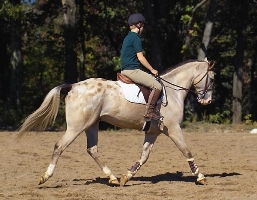Ashley Griffin, University of Kentucky
A good knowledge of how a horse learns and how to properly use reinforcement in training a horse will help you understand how the following factors affect learning:
Reinforcement Schedule
- Research has shown that horses work harder and maintain higher response rates when reinforcements are not on a predictable schedule. You should avoid becoming routine when reinforcing responses.
Length of Learning Session
- Long, concentrated learning sessions are an inefficient method of training horses. A more effective training method is to have more training sessions per week of shorter duration.
- Work on different maneuvers each day. Refrain from repetitive drilling on a maneuver after the horse has learned it well.
Inherent Emotionality
- Inherent emotionality is a horse’s emotional state. Each horse is different. Some horses will have a calm emotional state and be able to handle pressure, but others will be easily excitable and will not be able to handle as much pressure. Early handling helps the horse develop a calm emotional state. A good trainer quickly recognizes the emotional state of his or her horse and adjusts training regimens accordingly.
Age
- An older horse may have a decreased learning performance, most likely because it has learned to ignore the type of stimuli often utilized in learning.
Memory
- Horses have a very good memory. Research has shown that they can retain what they have been taught over time. One study reported an 81 percent retention rate after one month of learning 20 pairs of learned discriminations, a 78 percent retention after three months, and six months later, a 77.5 percent retention.
- Recent research in this area has shown that horses learn to learn. The learn-to-learn phenomenon is simple: The more tasks a horse learns to perform, the easier it will be for that horse to learn new tasks. These new tasks may be tasks that the horse will never use, but they will aid in learning ability.
Therefore, training should follow logical and progressive steps with timely and specific reinforcement. Remember, each horse will be different in how it responds to training and learning, so work schedules should reflect this difference.



